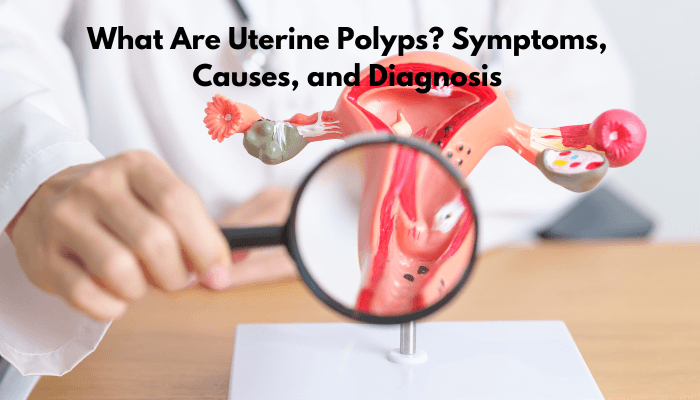Have you been experiencing unusual menstrual symptoms or issues with your reproductive health? You might be dealing with uterine polyps. These are small, often harmless growths that can appear on the lining of your uterus, but they can lead to various problems.
In this blog, Dr Pankhuri Gautam, a top gynecologist in Jaipur, will explain uterine polyps in simple terms. She will explain the symptoms to look out for, the causes behind these growths, and how doctors diagnose them. Whether you’re dealing with symptoms or just seeking information, this guide will help you better understand uterine polyps and how to manage them.
What Are Uterine Polyps?
Uterine polyps are benign growths that form on the lining of the uterus, known as the endometrium. These growths are typically attached to the uterine wall by a thin stalk and protrude into the uterine cavity. Uterine polyps can be small, about the size of a sesame seed, or large, comparable to a golf ball. While most uterine polyps are not cancerous, some can become cancerous over time.
Types of Uterine Polyps
- 1 Endometrial Polyps: These are the most common type, growing on the inner lining of the uterus. They are made up of endometrial tissue and can vary in size and number.
- 2 Cervical Polyps: These polyps grow on the cervix, the lower part of the uterus that opens into the vagina. Although less common, cervical polyps can cause symptoms like abnormal bleeding.
Symptoms of Uterine Polyps
Uterine polyps can cause a range of symptoms, though some individuals may not experience any noticeable signs. Recognizing the symptoms is important for early diagnosis and treatment.
Common Symptoms
- 1 Irregular Menstrual Bleeding: Women may experience irregular cycles, with heavier or lighter periods than usual.
- 2 Heavy Menstrual Periods: Abnormally heavy menstrual bleeding, which can cause discomfort and anaemia.
- 3 Bleeding Between Periods: Spotting or bleeding between menstrual periods can signify uterine polyps.
- 4 Postmenopausal Bleeding: Any bleeding after menopause is abnormal and should be evaluated by a healthcare provider.
- 5 Infertility or Difficulty Getting Pregnant: Polyps can interfere with the implantation of the embryo, leading to challenges in conceiving.
Less Common Symptoms
- 1 Pelvic Pain: Some women may experience discomfort or pain in the pelvic area.
- 2 Discomfort During Sexual Intercourse: Pain or discomfort during sex, which may lead to avoidance of sexual activity.
Causes of Uterine Polyps
The exact cause of uterine polyps is not fully understood, but several factors contribute to their development.
Hormonal Factors
Estrogen levels or fluctuations in estrogen levels can stimulate the growth of uterine polyps. This is why polyps are more common in women who are perimenopausal or postmenopausal, as hormonal changes during these stages can affect estrogen levels.
Risk Factors
- 1 Age and Menopausal Status: Most common in women between the ages of 40 and 50, particularly those who are nearing menopause or have gone through menopause.
- 2 Obesity: Excess body fat can lead to higher levels of estrogen, increasing the risk of developing uterine polyps.
- 3 Hypertension: High blood pressure has been linked to an increased risk of uterine polyps.
- 4 History of Cervical Polyps: Women who have had cervical polyps in the past may be at a higher risk of developing uterine polyps.
- 5 Use of Tamoxifen (Breast Cancer Treatment): Tamoxifen, a medication used to treat breast cancer, has been associated with an increased risk of developing uterine polyps.
Other Potential Contributing Factors
- 1 Genetic Predisposition: Some women may be genetically developing uterine polyps, although more research is needed to confirm this.
- 2 Chronic Inflammation of the Uterine Lining: Chronic inflammation, possibly due to infections or other conditions, can lead to the formation of polyps.
Diagnosis of Uterine Polyps
Diagnosing uterine polyps involves a combination of medical history evaluation, physical examination, and specific diagnostic procedures.
Initial Consultation and Medical History
The healthcare provider will ask about your symptoms, menstrual history, and any relevant medical conditions during the initial consultation. They will also inquire about your reproductive history and any medications you are taking.
Physical Examination
A pelvic exam will be performed to check for any abnormalities in the uterus or cervix. Although physical examination alone cannot confirm the presence of polyps, it helps identify other potential causes of symptoms.
Diagnostic Procedures
- 1 Transvaginal Ultrasound: Uses sound waves to create a picture of the uterus and can help detect polyps. A transducer is inserted into the vagina, allowing for detailed images of the uterine lining.
- 2 Sonohysterography: Injecting a saline solution into the uterus during an ultrasound. The saline expands the uterine cavity, providing a clearer view of the uterine lining and making it easier to detect polyps.
- 3 Endometrial Biopsy: A small sample of the uterine lining is removed and examined under a microscope. This can help identify polyps and check for abnormal cells that might indicate cancer or precancerous conditions.
Treatment Options for Uterine Polyps
The treatment of uterine polyps depends on various factors, including the size and number of polyps, the severity of symptoms, and the patient’s overall health and preferences. Here are the common treatment options:
Watchful Waiting for Asymptomatic Polyps
A wait-and-see approach may be recommended for small polyps that are not causing any symptoms. Regular monitoring with periodic ultrasounds can help ensure the polyps are not growing or causing issues.
Medications
Hormone-based medications, such as progestins, may help shrink polyps and reduce symptoms. These medications can be effective in managing symptoms, but polyps often return once the medication is stopped.
Surgical Procedures
- Polypectomy (Removal of Polyps): This is a simple surgery where doctors remove the polyps using a thin, flexible tube inserted through the vagina. It’s a minor procedure; most people can go home the same day. Removing the polyps usually helps with symptoms and prevents future problems.
- Hysteroscopic Resection: During this procedure, use special tools to remove the polyps while looking inside the uterus with a small camera. This method is very effective and ensures that all polyps are removed completely.
Prevention and Management of Uterine Polyps
Preventing uterine polyps can be challenging due to the influence of hormonal and genetic factors. Still, certain lifestyle changes and regular medical care can help manage the risk and detect polyps early.
- Regular Medical Check-Ups
- Managing Underlying Health Conditions
- Lifestyle Changes
Conclusion
Uterine polyps are common benign growths that can cause a variety of symptoms, including abnormal bleeding and fertility issues. Understanding the symptoms, causes, and diagnostic methods is crucial for timely and effective treatment. By maintaining a healthy lifestyle, you can manage and prevent uterine polyps effectively.
If you experience any symptoms related to uterine polyps, I, Dr. Pankhuri Gautam, encourage you to seek medical advice promptly. Visit our clinic for a thorough evaluation and personalized care to ensure the best possible treatment and management of your condition.



